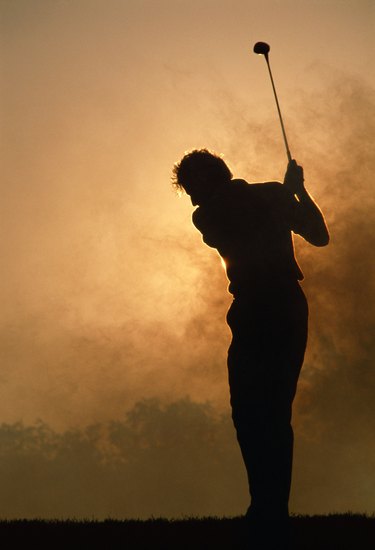
While it may seem like a gentle game when compared to contact sports such as football and hockey, golf presents its own unique physical demands, with the nature of the golf swing lending itself to repetitive stress injuries. Golfers may experience the painful condition medial epicondylitis, or golfer's elbow, which causes severe discomfort in the inner side of the elbow and throughout the forearm due to repeated wrist flexion. Wearing a special brace may support the strained muscle tendons and alleviate the pain associated with golfer's elbow.
Identification
Video of the Day
A standard golfer's elbow brace is a single elastic strap that wraps around the forearm. The strap typically features a shock-absorbing, counter-pressure pad to brace the strained muscle tendons. A medal D-ring and Velcro patches provide a secure fit, securing the strap to the arm in the same fashion as a blood pressure cuff.
Video of the Day
Location
When pulling on the brace, place the top edge of the strap two finger-widths below the crease of your elbow. Position the shock-absorbing foam pad on the inside of the forearm. Slip the end of the elastic strap through the D-ring and fasten it back against itself. Be careful not to pull the strap too tight, cutting off circulation. The goal is firm, comfortable pressure. If unsure about sizing, measure the widest part of your forearm and then consult the brace's packaging to determine the appropriate strap size.
Consideration
To test the brace's effectiveness, hold your forearm out with your palm up and make a fist. Now attempt to curl your wrist while someone else applies resistance to your fist. If you experience any pain, it means the shock-absorbing pad requires an adjustment. Make certain the strap is tight enough to offer support. If the pain persists, move the shock-absorbing pad right or left until you find a spot that allows you to curl your wrist without discomfort.
Misconceptions
Even though they're both repetitive stress injuries, cause similar symptoms and may be treated with the exact same brace, golfer's elbow and tennis elbow are not the same condition. Tennis elbow, or lateral epicondylitis, causes pain on the outside of the elbow, not the inside. If experiencing tennis elbow, position the strap's shock-absorption pad on the outside of the forearm as opposed to the inside for golfer's elbow. Also, reverse the testing method, lifting the back of your hand toward the ceiling to confirm correct strap placement.